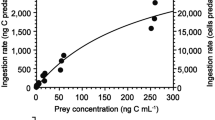Abstract
Moerisia lyonsi Boulenger (Hydrozoa) medusae and benthic polyps were found at 0 to 5‰ salinity in the Choptank River subestuary of Chesapeake Bay, USA. This species was introduced to the bay at least 30 years before 1996. Medusae and polyps of M. lyonsi are very small and inconspicuous, and may occur widely, but unnoticed, in oligohaline waters of the Chesapeake Bay system and in other estuaries. Medusae consumed copepod nauplii and adults, but not barnacle nauplii, polychaete and ctenophore larvae or tintinnids, in laboratory experiments. Predation rates on copepods by medusae increased with increasing medusa diameter and prey densities. Feeding rates on copepod nauplii were higher than on adults and showed no saturation over the range of prey densities tested (1 to 64 prey l−1). By contrast, predation on copepod adults was maximum (1 copepod medusa−1 h−1) at 32 and 64 copepods l−1. Unexpectedly, M. lyonsi colonized mesocosms at the Horn Point Laboratory during the spring and summer in 4 years (1994 to 1997), and reached extremely high densities (up to 13.6 medusae l−1). Densities of copepod adults and nauplii were low when medusa densities were high, and estimated predation effects suggested that M. lyonsi predation limited copepod populations in the mesocosms. Polyps of M. lyonsi asexually produced both polyp buds and medusae. Rates of asexual reproduction increased with increasing prey availability, from an average total during a 38 d experiment of 9.5 buds polyp−1 when each polyp was fed 1 copepod d−1, to an average total of 146.7 buds polyp−1 when fed 8 copepods d−1. The maximum daily production measured was 8 polyp buds and 22 medusae polyp−1. The colonizing potential of this hydrozoan is great, given the high rates of asexual reproduction, fairly wide salinity tolerance, and existence of a cyst stage.
Similar content being viewed by others
Author information
Authors and Affiliations
Additional information
Received: 29 October 1998 / Accepted: 3 March 1999
Rights and permissions
About this article
Cite this article
Purcell, J., Båmstedt, U. & Båmstedt, A. Prey, feeding rates, and asexual reproduction rates of the introduced oligohaline hydrozoan Moerisia lyonsi. Marine Biology 134, 317–325 (1999). https://doi.org/10.1007/s002270050549
Issue Date:
DOI: https://doi.org/10.1007/s002270050549




